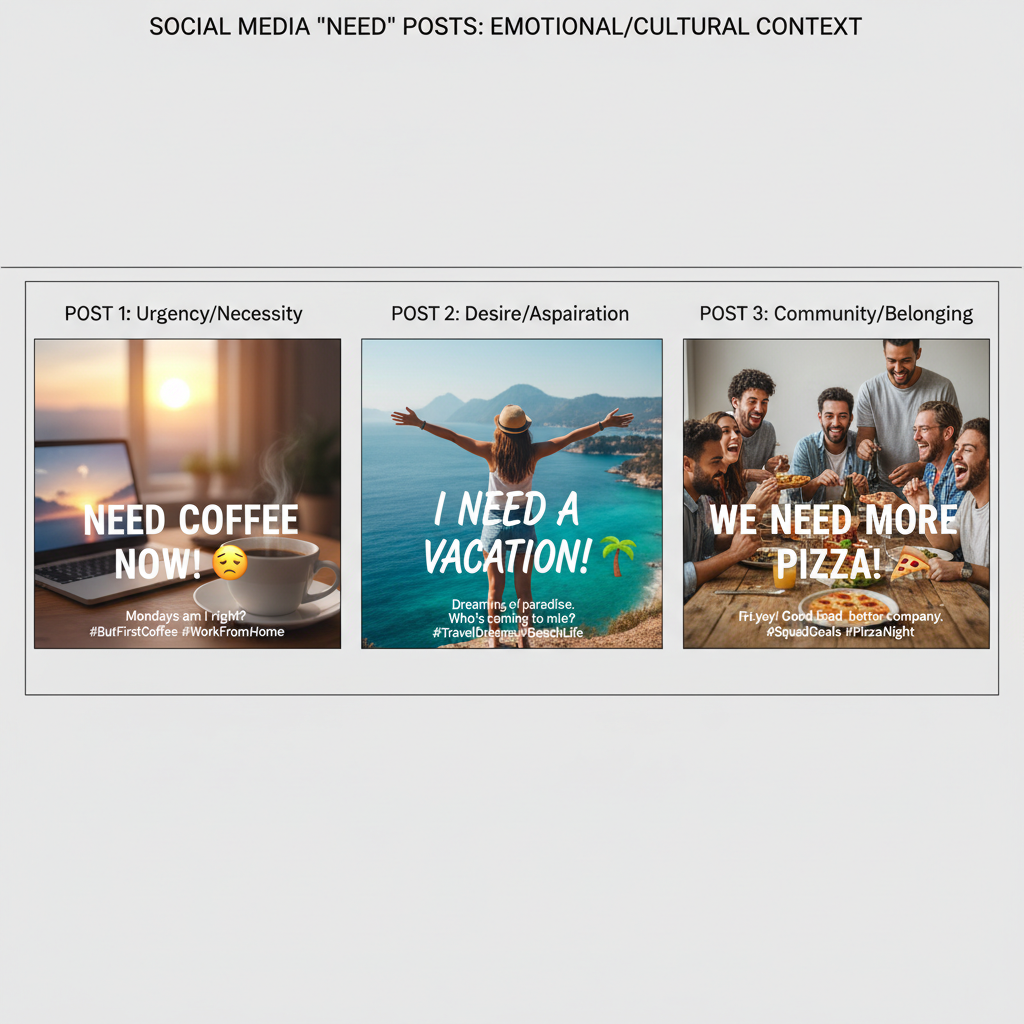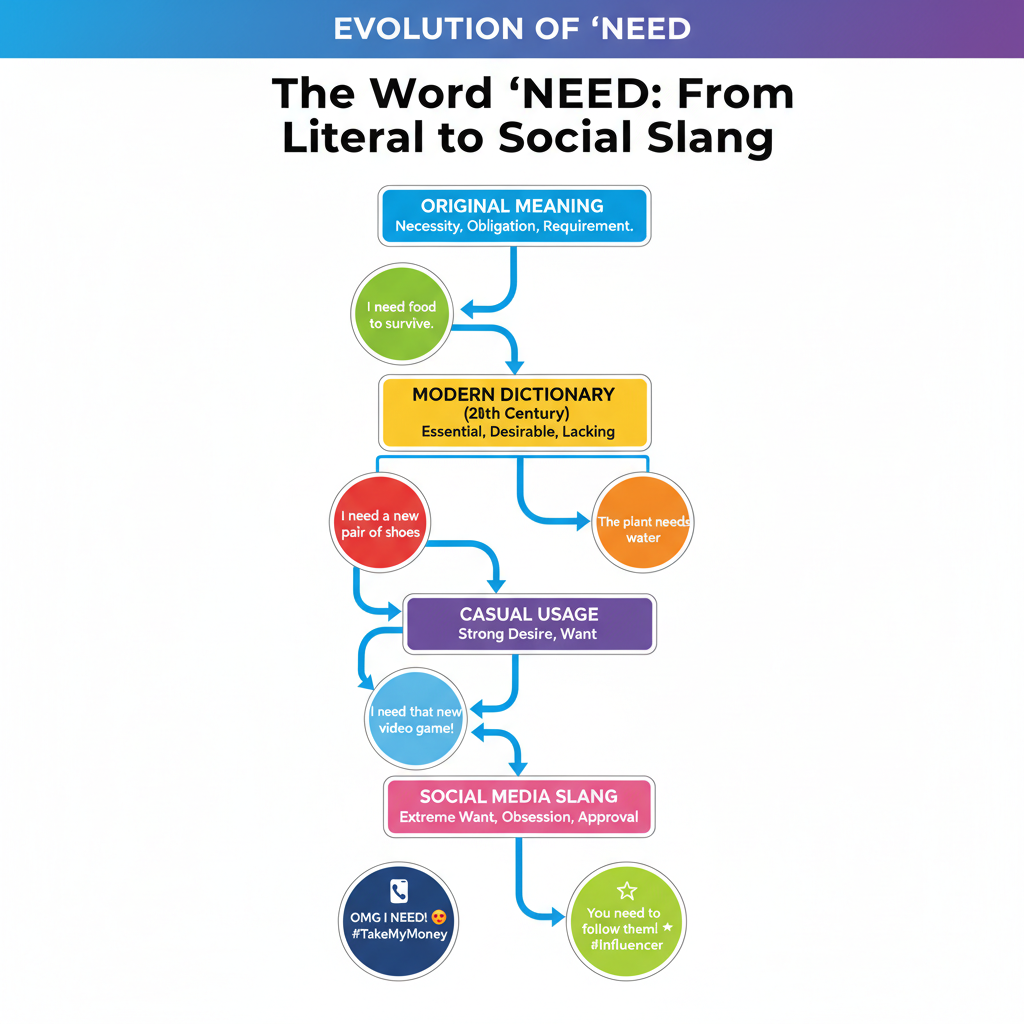Que significa need en redes sociales y su uso común
Explore how "need" evolved from literal necessity to playful slang in social media, with examples, cultural insights, and platform-specific usage.

Introduction: Understanding "Need" in Social Media Contexts
Scrolling through TikTok, Twitter (now X), or Instagram, you’ve probably seen captions like “I need this 💖” or “Need! 😭.” For native speakers, the meaning often feels self‑evident, but for learners or those outside certain online circles, understanding what “need” means in social media slang reveals much about digital language trends. This guide explains qué significa "need" en redes sociales, tracing its evolution from literal necessity to playful hyperbole, with examples, cultural insights, and its growing role in brand marketing.
---
From Literal Meaning to Slang Evolution
Traditionally, “need” indicates an essential requirement—something vital to survival, like food, water, or shelter. However, online communities frequently exaggerate ordinary language to heighten emotional or comedic impact. In social media slang, “need” has shifted to express intense yet non‑essential desire.
For example:
- Literal: I need water after running.
- Slang: I need that hoodie, it’s perfect.
This shift demonstrates how internet discourse adapts words to align with expressive, meme‑driven cultures, making “need” a shorthand for excitement or strong appeal.
---
Platforms Where "Need" Dominates
The casual yet emphatic use of “need” thrives where fast reactions and visual storytelling dominate.
1. Twitter / X
Short, spontaneous updates make “need” an efficient way to show enthusiasm or deep interest toward tweets, memes, or items.
2. TikTok
Captions such as “POV: you see this and need it” or simple “NEED” comments beneath trending clips amplify the playful urgency common on the platform.
3. Instagram
Within Stories, Reels, and posts, “need” appears alongside product tags, outfits, or destinations, especially in influencer and lifestyle content.

---
Examples of "Need" in Social Media Posts
To clarify qué significa need en redes sociales, here are stylized examples with interpretations:
| Post Example | Literal Translation | Slang Meaning |
|---|---|---|
| "Need this cat in my life 🐱" | Necesito este gato en mi vida | Strong emotional reaction, desire to have the cat |
| "NEED. Like right now." | NECESITO. Justo ahora. | Over‑the‑top way to say something is so appealing it feels urgent |
| "Add to cart. Need!" | Agregar al carrito. ¡Necesito! | Playful signal to buy something impulsively |
---
Emotional and Cultural Implications
Posting “I need” rarely means actual necessity. Instead, it conveys:
- Emotional excitement — spur‑of‑the‑moment joy, admiration, or desire.
- Cultural belonging — joining in trends or aesthetics embraced by an online community.
- Identity signaling — displaying personal taste via chosen items, videos, or art.
This slang style inflates emotional expression, increasing engagement and relatability. Often, part of the joke is its obvious exaggeration.
---
"Need" vs. Similar Slang Terms
“Need” exists alongside other high‑energy expressions—each with unique tone and intensity:
| Term | Core Emotion | Intensity Level | Common Usage |
|---|---|---|---|
| Need | Strong desire, urgency | High | Reactions, trending products |
| Want | Simple desire | Medium | Lists, plans, aspirations |
| Must have | Essential in collection | Very high | Fashion, gadgets |
| Obsessed | Long‑term enthusiasm | High but enduring | Fandoms, hobbies |
Recognizing these subtle distinctions improves reading and using social media language effectively.
---
Generational and Subcultural Variations
Generational Use
- Gen Z — Employs “need” with irony or exaggerated flair.
- Millennials — Mix slang “need” references with lifestyle branding and curated posts.
- Older users — Often adhere to literal meaning, but may adopt slang in memes for humor.
Subcultural Adoption
Within niches like K‑Pop fandoms, gaming, or streetwear, “need” becomes shorthand for shared excitement over new drops or announcements.

---
Potential Misinterpretations
For non‑native speakers or those outside certain internet cultures, “need” can be misleading:
- It may be mistaken for an urgent requirement instead of playful desire.
- The direct translation loses humorous exaggeration.
- Context is key—caps (“NEED”) and emojis often signal hyperbole.
In some languages, “I need” feels too intense for casual use, yet online English treats it lightly and with humor.
---
How Brands and Marketers Leverage "Need"
Brands have embraced “need” to align with organic social media conversations:
- “The boots you didn’t know you needed”
- “Need‑worthy tech drops”
- “We need you in our community”
This approach works because:
- It mirrors everyday digital speech.
- It suggests urgency, boosting conversions.
- It ties products to emotional resonance.
Influencer partnerships frequently encourage “need” captions for relatable but promotional messaging.
---
Tips for Understanding Evolving Social Media Slang
To navigate platforms fluently:
- Observe surrounding context—humor, imagery, and emojis matter.
- Note tone—capitalization like “NEED” amplifies drama.
- Identify audience—youth‑heavy communities use slang more liberally.
- Learn related expressions—terms like “want,” “must have,” and “vibes” broaden comprehension.
Continual exposure to emerging slang keeps you adaptable in online discussions.
---
Conclusion
So, qué significa need en redes sociales? It’s far less about literal necessity and more a shorthand for strong, sometimes exaggerated desire. Whether it’s a puppy clip, coveted sneakers, or a stunning travel photo, “need” signals emotional pull, cultural participation, and a dash of humor.
Its journey from standard English to meme‑rich internet slang illustrates how language evolves within digital spaces. Understanding its playful intent lets you engage more meaningfully with TikTok, Twitter/X, and Instagram—perhaps incorporating it into your own posts. Keep tracking these linguistic shifts to remain fluent in the vibrant, fast‑moving language of the online world.
Ready to decode more social media slang? Follow language trends and try using “need” in your next post to connect and resonate with your audience.




